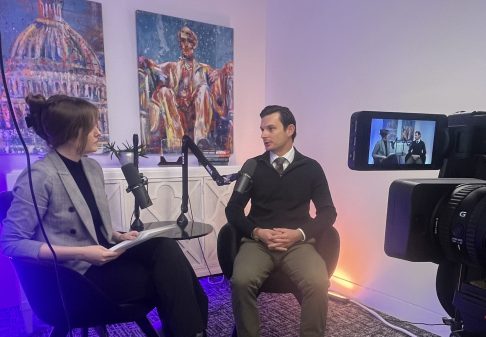Political vs. career CIOs: Former IT chiefs weigh merits of both following OPM guidance

During the first few weeks of the current Trump administration, the Office of Personnel Management asked federal agencies to make an administrative change that would open the door to more political appointees in the government’s top roles for IT leadership: chief information officers.
Acting OPM Director Charles Ezell told agencies in a February memo that the CIO role “has changed dramatically in recent years” and is “no longer the station of impartial and apolitical technocrats.” To reflect that change, Ezell recommended agencies redesignate “career reserved” CIO roles — which can only be filled by a career civil servant — to “general,” a type of role that can be filled by a career or political appointee.
The guidance signaled the importance of CIOs for the Trump administration’s plans — particularly the software and technology-focused marching orders for the Department of Government Efficiency team. But among people who have held that title within agencies, reactions are mixed.
In conversations with FedScoop, nine former agency CIOs cited positives for both political and career appointments. That includes the ability of a political appointee to bring in fresh eyes and have an easier appointment process, and a career appointee’s institutional knowledge and potential to provide stability between administrations.
But that sampling of formers, which was composed of career and political appointees who served during Democratic and Republican administrations, differed slightly on just how much they welcomed the guidance. While some were more supportive of the desire to have more politically appointed CIOs as a way to align the position with an administration’s priorities, others questioned the motive of the guidance as a way to politicize the role and cautioned against blanket changes.
The bottom line: It generally comes down to who is in the role and not just their designation as career or political.
“The advantage depends upon what you’re trying to accomplish at any given time and whether the best person for the job is sitting in the government right now or not,” Ann Dunkin, who served as CIO at the Department of Energy during the Biden administration, said of political appointments.
Fresh perspectives, career support
Formers generally agreed that political CIOs are able to bring in an outside perspective and propensity for bold actions that can be valuable to an organization.
Dunkin, for example, said there’s a right time when having a political in the top IT role is helpful — partly because they bring a fresh perspective and partly because their political standing and potentially shorter tenure make them more willing to take on big challenges.
“While none of the folks that I would aspire to be as a political CIO go around burning bridges, there’s a little bit more willingness to do some hard things because they’re not worried about their federal career,” said Dunkin, who was a political appointee.
She added that it doesn’t mean a political would be doing destructive things, but rather “hard things.” Sometimes departments might benefit from “a little bit of a poke” or “shake up,” Dunkin said, but “not chaos” or “wholesale disruptions.”
One former federal government CIO who was politically appointed — and was granted anonymity to speak more candidly — said that people in career tracks can be “more worried about making a mistake than they are worried about, ‘are they going to be moving fast enough?’”
That worry is just human nature, the former political appointee said, because career officials are likely concerned about balancing risks with the ability to support their families. Political appointees, on the other hand, often don’t need the job financially and are there to serve a purpose, the source said. As a result, they can say and do things that “you can’t expect a career civil service person to say or do.”
Changing the designation of the role could ultimately change the calculus for career officials, the source said. If those officials aren’t seen as accelerating progress on the secretary’s agenda, they could worry about being replaced more easily. “That’s the whole point of this,” they said.
John Zangardi, who was the CIO at the Department of Homeland Security during the first Trump administration, pointed to the ability of new leadership in a CIO post to be innovative and take advantage of a broader pool for potential talent.
“Fresh perspectives can bring about meaningful change,” said Zangardi, who also served as acting CIO for the Department of Defense. “While institutional knowledge and practical experience are valuable and should be a consideration, the ability to adapt, foster collaboration, and execute a forward-looking vision is what truly defines success in this role.”
What matters, when it comes to political appointments, is having the right career team, governance structure and funding mechanisms around a leader, said Jonathan Alboum, who served as the U.S. Department of Agriculture’s CIO during the Obama and Trump administrations.
“What the memo says is OK, and you can have a political in these roles if you have these other things,” Alboum said. But if an agency doesn’t have that kind of support for the role, it can create risks for long-term modernization initiatives and multi-year projects. “It’s just so important that we are mindful of the need to do both,” he said.
Alboum said he was selected for the USDA role as a political but ended up assuming it as a career official. He maintained his status as a career throughout his time in government, which also included IT leadership roles at the General Services Administration. Speaking from that experience, Alboum said politicals could articulate the objectives of the administration but would turn to him for questions about technology, cost, maintenance, and risks.
“These things work best when there’s a real dialogue between the appointees and the career team,” he said.
The CIO landscape
CIO posts within federal agencies already generally vary in terms of political and career appointees.
Just two, the Department of Veterans Affairs and DOD, are presidentially appointed and Senate-confirmed. DHS, meanwhile, is presidentially appointed but not Senate-confirmed. And during the Biden administration, the departments of Energy and Transportation and the Social Security Administration all had non-career CIOs, according to data from the Plum Book, a dataset of government roles maintained by OPM. That implies those positions are “general.”
CIO roles can also be in different “pay schedules” that correspond with the hierarchy of that position. For example, top IT chiefs at the VA, DHS and DOD are part of the executive schedule, which includes the highest-ranked officials, while most other CIO posts are part of the senior executive service, or SES. The memo from OPM specifically focused on those roles.
While a couple of agencies have opted to change the designation of their positions in light of the new OPM guidance, many were already “general.”
In response to a FedScoop request for comment to Chief Financial Officers Act agencies, just the National Science Foundation and the Department of State said they updated the designation of their CIO roles. Moreover, six agencies said their CIO role already had the “general” designation: OPM, the Department of Interior, GSA, NASA, the Environmental Protection Agency, and the Nuclear Regulatory Commission.
The Department of Health and Human Services said it was complying with OPM and wouldn’t clarify beyond that statement, the Justice Department declined to comment, and a dozen other agencies didn’t provide a response to multiple requests for comment.
A subsequent OPM memo on redesignation requests, however, provided more insight into career-reserved roles. Per a list of roles mentioned in that memo, the CIO positions at HHS and DOJ, as well as the Small Business Administration and the departments of Education and Housing and Urban Development, are all career-reserved. Overall, that list had nearly 80 CIO positions at various agencies and sub-agencies.
When asked which agencies had requested to change the designations of their roles, OPM didn’t provide a comment.
‘Maximum flexibility’
Several of the formers said the change recommended in the guidance likely won’t dramatically alter the landscape for CIOs.
André Mendes, who was the first career CIO at the Department of Commerce, said he saw the memo as the administration’s attempt to provide itself with “maximum flexibility” and noted that there can be issues with either designation.
As Commerce CIO, Mendes said he felt he “inherited a lack of continuity” and departmentwide strategy when he came into the job, describing the dynamics as “counterproductive” and “wasteful.” He said that was likely due to the high turnover rate among the CIOs that came before him.
“The fact that I became the longest-tenured CIO in the Department of Commerce, having been around for what amounted to three-and-a-quarter years, tells you everything you need to know in terms of continuity,” Mendes said.
It comes down to the person in that position, Mendes said. If a political comes in and is competent and willing to take on the risk needed for change, then he said he’s “all for it.”
On the other hand, if roles were only career-reserved and people went from one agency to another and were eventually promoted to CIO out of convenience rather than acumen, Mendes said then he’d have a problem with that, too.
For Mark Forman, who under George W. Bush was the first U.S. administrator for e-government and IT (which later became what is known now as the Federal CIO), the change to CIO roles didn’t seem all that big.
“I know everybody’s worried about it, but it’s the way it’s always been,” Forman said. “The CIOs are there to help the agency achieve its performance objectives and to make sure modern technology is used appropriately in that approach.”
The one thing the memo might change about the position is a premium on effectiveness and possibly a premium on loyalty, Forman said, but he also said he doesn’t think it should be afraid of that.
“If the focus of loyalty is showing that you’re helping the government achieve its objectives, improving effectiveness and efficiency, that’s a noble cause,” Forman said.
Question of scope
But one common concern about the memo was its potential scope. Specifically, some of the formers noted that the desire for politicals could bleed into lower-level agencies and subcomponents where they may actually be less useful.
John Sherman, who served as DOD CIO during the Biden administration and the Intelligence Community CIO during the first Trump administration, said that for department-level and major agencies, there is a rationale to have political appointees.
“Although there’s not a Democratic or Republican way necessarily to do IT, cyber, software mod, it does help to have someone who is in the formation with whoever the administration leaders are because there are different emphasis items,” Sherman said. In the current Trump administration, for example, Sherman expects a focus on nearer-term delivery of IT services rather than items that are on the horizon.
But while a political might make sense for larger, department-level agencies, at lower levels, a career leader might be the better choice.
He gave the example of the National Geospatial-Intelligence Agency, where he started his government career, saying the agency has a mix of modern and older IT. If a political were installed at NGA or agencies like it, Sherman said, “I think that, to me, would not be advisable, because you need someone who kind of not only grew up there but understands all that ecosystem.”
Dunkin similarly said it’s unclear from the wording of the memo if OPM intends to include CIOs in lower levels of organizations. “To me, that’s more problematic, particularly if you do it broadly,” Dunkin said.
At DOE, for example, there are multiple people with CIO titles — some formal and some informally — Dunkin said. Those roles are where the organizational knowledge that careers have can matter just as much or more than subject matter expertise in IT, she said. Additionally, the turnover at the end of an administration would also be massive.
“It’s very disruptive to have all your CIOs walk out the door on one day — just like it’s disruptive to have all your Cabinet secretaries walk out the door on one day. The difference is, the Cabinet secretary positions get filled really fast,” Dunkin said.
Sherman noted there are, of course, circumstances where that might not be the case and a political could be useful in a lower-level agency as well, but that determination depends on the needs of the organization. Throwing out all career CIOs “could put some missions at risk,” he said.
Potential for politics
Ultimately, among some of the formers, there was a fear that the guidance from OPM could actually open up the role to politics, particularly given the current administration’s simultaneous moves to reshape the federal government through the DOGE.
Keith A. Jones, who most recently served in the government as the State Department’s CIO early in the Biden administration, said that political CIOs often come to the role with a strong focus on the mission of the agency and they work to address those priorities. But having the political designation does not and should not “draw the leader directly into political whims.”
“However, the recent memo and its timing certainly appear to be the current Administration’s attempt to politicize the position, influencing data reporting and decision-making,” Jones said in an emailed statement.
In the first few days of the Trump administration, Melvin Brown II was swapped out of his position as OPM’s CIO after just one week in the role. Brown had served as deputy CIO for roughly four years and previously held various IT roles at DHS. He was replaced by Greg Hogan, who was formerly the vice president of infrastructure at comma.ai, which says it makes Tesla-like autopilot technology for cars. According to a declaration in a lawsuit against the administration, Hogan began at OPM on Jan. 20.
That change in IT leadership came before OPM introduced a governmentwide email capability that quickly prompted a challenge over employee privacy concerns, and was particularly noteworthy as Hogan was the one to review an initial — and later revised — privacy impact assessment for the system.
Sherman said that the motive of changing designations shouldn’t be “cleaning the bureaucrats out.” Political selections still need to have the skills, understanding of the mission, and leadership, he said. “My respectful plea on this would be, if they are going to bring in non-career people, let’s do it for the right reasons,” Sherman said.
Another former politically appointed agency CIO who spoke to FedScoop on the condition of anonymity, again to speak frankly, warned that leaders need to be careful with politicizing tech because it can be wasteful, costly, and, depending on the use, affect people’s lives.
That former said they were brought in from industry because the agency leader had known they wanted a CIO with a particular skill set that the agency needed. Despite their appointment, the source said they “never felt political in that job.”
“If you really want to get competent people, you don’t do it by cult of personality,” they said. Instead, it should be done by “a cult of capability.”
FedScoop’s Billy Mitchell and Caroline Nihill contributed to this report.






